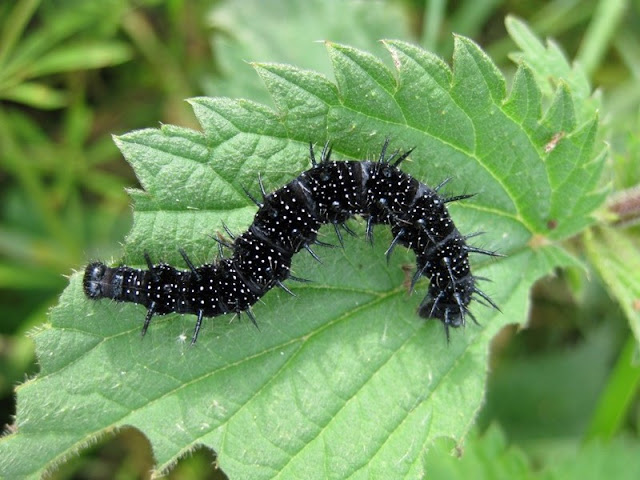The Peacock butterfly is reasonably common here in East
Lothian. They over-winter as adult butterflies, seeking out dark places, such
as old sheds and buildings, or deep in log piles in which to hibernate.
They are often the first butterfly of the year to be seen,
appearing on a sunny day in February or March. The adults go on to breed and
lay their eggs in large clusters on the underside of nettle leaves in May or
June. Depending on the weather the eggs will go on to hatch about two weeks
later. The caterpillars will take about four or five weeks before they pupate.
They will remain as chrysalises for somewhere around two to four weeks,
depending on the temperature.
So, there is one generation of this butterfly each year. The
adult butterflies emerge here in August and their numbers peak around the
middle of the month. They slowly reduce in numbers as they start to hibernate
and by October we only see the odd sighting. However, after hibernation these
same butterflies will be on the wing until June the following year. So,
potentially, an adult can survive for up to ten months.
Last year I found an enormous group of caterpillars in a
patch of nettles in a field where I walk our dog. I estimate that there must
have been over 200 caterpillars there. I took this picture with my phone on 19th July, just
as the weather took a turn for the worst.
The following day (the 20th) I collected three caterpillars
and put them on some nettles I had picked, which I placed in a cage in the
garage next to the window. They were at least out of the rain and protected
from predators.
By the following evening, they were all hanging upside down
from the nettles, looking as though they were about to pupate. They remained
like that all day on Saturday 22nd, which was particularly wet and cold.
On Sunday morning, when I took a look, they had all turned
into chrysalises.
During that period we had torrential rain for three days and when I took a look at the nettle patch I couldn't find any of the other caterpillars. I don't know if they had perished, or if they had also turned into chrysalises, which I couldn't find.
I had to wait for 24 days for my three chrysalises to emerge into
butterflies on 15th August. I took the picture below before I went to work. You can see the pattern of the wing showing through the chrysalis.
The under-side of their wings is really well camouflaged among the dead nettle leaves, unlike the upper-side which is so beautiful.








Super post Nick, really enjoyed it.
ReplyDeleteThank you Brian.
Delete¡Qué buena idea, Nick! has conseguido un serie maravillosa del nacimiento de esta bella mariposa. Un fuerte abrazo desde Asturias.
ReplyDeleteGracias, Belen
DeleteAnother of your lovely and interesting posts, Nick!
ReplyDeleteThe peacock is such a gorgeous butterfly although common.
Keep well and enjoy your week :)
Thank you Noushka.
DeleteThe early stages of the chrysalises mimic the leaves so well, only you can tell with your trained eye. I wouldn't have noticed!
ReplyDeleteThanks Maria. I think that the chrysalis of most species of butterflies is the most difficult stage to find.
DeleteOh wow, the upper side is far far off from the camouflaging undersides when closed. I can't imagine that beautiful color in the beginning while you are still describing them at earlier stages. If that were me maybe i wouldn't have notice the black butterfly.
ReplyDeleteYes. These butterflies are remarkably well camouflaged. When disturbed they flick their wings open revealing their "eyes" which must give potential preditors a bit of a fright!
Delete